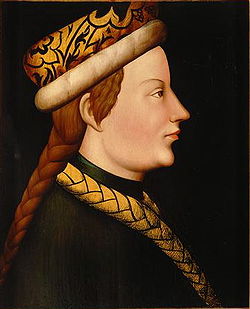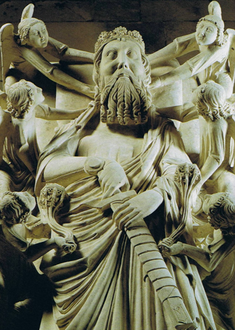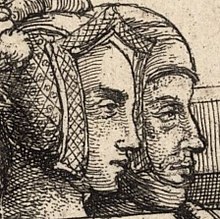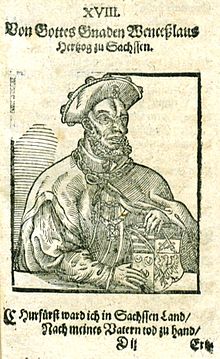Otto II, Count of Waldeck (before 1307 – 1369) was Count of Waldeck from 1344 until his death.
Frederick V of Nuremberg (before 3 March 1333 – 21 January 1398) was a Burgrave (Burggraf) of Nuremberg, of the House of Hohenzollern.
He was the elder son of John II of Nuremberg and Elisabeth of Henneberg. From the death of his father in 1357, Frederick bore the title of Burgrave and so was responsible for the protection of the strategically significant imperial castle of Nuremberg. His zeal in the imperial cause led Charles IV to elevate him in 1363 to be the first Burgrave of royal rank.
Elisabeth of Meissen, Burgravine of Nuremberg (22 November 1329 – 21 April 1375) was the daughter of Frederick II, Margrave of Meissen and Mathilde of Bavaria and a member of the House of Wettin.
James (16 January 1315[1] – 17 May 1367[2]) was the Lord of Piedmont from 1334 to his death. He was the eldest son of Philip I and Catherine de la Tour du Pin. While his father had abandoned his claim to the Principality of Achaea in 1307, James continued to use the princely title and even passed it on to his successors.
Margaret (1346 – 1402), daughter of Edward I of Beaujeu
Duke Stephen II of Bavaria (1319 – 13 May 1375, Landshut) (German: Stephan II mit der Hafte, Herzog von Bayern), after 1347 Duke of Bavaria. He was the second son of Emperor Louis IV the Bavarian by his first wife Beatrix of Świdnica and a member of theWittelsbach dynasty.

Elisabeth of Sicily (1310–1349) was a daughter of Frederick III of Sicily and Eleanor of Anjou. Her siblings included: Peter II of Sicily and Manfred of Athens. She is also known as Isabel of Aragon.
Albert III of Austria (9 September 1349 – 29 August 1395), known as Albert with the Braid (German: Albrecht mit dem Zopf), a member of the House of Habsburg, was Duke of Austria from 1365 until his death.
Albert III was born in the ducal residence of Vienna, the third son of the Habsburg duke Albert II of Austria and his wife Joanna of Pfirt. Even though his father had determined a house law, whereby the four sons were obliged to rule jointly and equally, the eldest brother Rudolf IV assumed the reins of government after his father's death in 1358. He reaffirmed his supremacy issuing thePrivilegium Maius, however, as his marriage remained childless he again had to share his power with his younger brothers. In 1365 Rudolf IV, Albert III, and Leopold III together signed the foundation certificate of the Vienna University (Alma Mater Rudolphina Vindobonensis); Rudolf died a few months later at the age of 25.

Beatrix of Nuremberg (c. 1362, Nuremberg – 10 June 1414, Perchtoldsdorf) was a daughter of Frederick V, Burgrave of Nuremberg and his wife Elisabeth of Meissen.

Duke Albert I (German: Albrecht; 25 July 1336, Munich – 13 December 1404, The Hague) KG, was a feudal ruler of the counties ofHolland, Hainaut, and Zeeland in the Low Countries. Additionally, he held a portion of the Bavarian province of Straubing, his Bavarian ducal line's appanage and seat.
Albert was the third son of Louis IV, Holy Roman Emperor from his second wife Empress Margaret, who was the daughter of William III, Count of Holland and Hainaut. Albert was originally a younger son, apportioned at best an appanage. He was only 10 years old when his father died, leaving most of his Bavarian inheritance to his eldest half-brother, Louis V, Duke of Bavaria, but also some appanages to the younger sons.
Margaret of Brieg (1342–1386) was a daughter of Ludwik I the Fair and his wife, Agnes of Sagan. She was Duchess consort of Bavaria by her marriage to Albert I, Duke of Bavaria.
Otto II of Nassau (c. 1305 – 1351) was a German nobleman. He was a Count of Nassau-Dillenburg in Siegen and Dillenburg, and was a son of Count Heinrich of Nassau and Adelheid of Heinsberg.[
Adelheid of Vianden, daughter of Philip of Vianden and Adelheid of Arnsberg
Adolph II of the Marck (died 19/20 October 1347, Fröndenberg) was Count of the Marck.
He was the eldest son of Engelbert II of the Marck and Mechtild of Arenberg.
Margaret of Cleves, also spelled Margaretha or Margarethe, (c. 1310 – after 1348) was the wife of Count Adolf II of the Marck and mother of Adolf III of the Marck. She was a daughter of Count Dietrich VIII of Cleves and Margaret of Guelders, who was a daughter of Reginald I of Guelders.
John III, Lord of Polanen (c. 1325 – 3 November 1378 in Breda) was Lord of Polanen, Lord of De Lek and Lord of Breda.
He was a son of John I, Lord of Polanen and Catherine of Brederode.
Oda of Horne-Altena (1318-1353)
Johann von Salm 1335-1400 Simon I, Graf von Salm y Mathilde von Saarbrücken
| ||||||||||||||||||||
Ernest I of Brunswick-Grubenhagen (German: Ernst I., Fürst von Braunschweig-Grubenhagen ; c. 1297 – 9 March 1361) wasPrince of Brunswick-Grubenhagen.
He was the son of Henry I, the Admirable and his wife Agnes, née Countess of Meissen. Henry the Admirable founded the Principality of Grubenhagen in 1291, after the Guelph princes had divided their inheritance. Ernest originally intended to follow a spiritual career, but after his father's death, he and his brothers Henry II and William jointly ruled the principality.
Adelheid of Everstein-Polle (died after 29 September 1373), daughter of Count Henry II of Eberstein.
Magnus (1324–1373), called Magnus with the Necklace (Latin: Magnus Torquatus) or Magnus II, was Duke of Brunswick-Lüneburg, ruling the Brunswick-Lüneburg principalities of Wolfenbüttel (colloquially also called Brunswick) and, temporarily,Lüneburg.
Magnus was the son of Magnus the Pious, Duke of Brunswick-Lüneburg (Wolfenbüttel).
Catherine, daughter of Bernhard III, Prince of Anhalt-Bernburg
Duke Ernest I of Brunswick-Göttingen (c. 1305 – 24 April 1367[1]) was a member of the Guelph dynasty and was Duke ofBrunswick-Göttingen from 1344 until his death.
Ernest was a son of Duke Albert II of Brunswick-Wolfenbüttel-Göttingen and his wife, Rixa of Werle. In the division of 1286, his father had received the Principality of Göttingenand in 1292, he inherited Principality of Brunswick-Wolfenbüttel from his childless brother William I. After his father's death in 1318, Ernest's older brother Otto the Mild took up government. After Otto died childless in 1344, Ernest and his older brother Magnus I divided the Duchy. Ernest received the Principality of Göttingen, which would remain separated from the rest of Brunswick for a while.
William VII of Jülich, 1st Duke of Berg (c. 1348 – 25 June 1408) was born in Jülich, as the son of Gerhard VI of Jülich, Count of Berg and Ravensberg, and Margaret, daughter and heiress of Otto IV, Count of Ravensberg, and Margaret of Berg
Anna of the Palatinate (1346 – 30 November 1415), daughter of Rupert II, Elector Palatineand Beatrice of Sicily.
Peter I (Portuguese: Pedro I [ˈpedɾu] (8 April 1320 – 18 January 1367), called the Just or the Cruel) (Portuguese: o Justo, O Cruel), was King of Portugal and of the Algarve from 1357 until his death.[1] He was the third but only surviving son of Afonso IV of Portugal and his wife, Infanta Beatrice of Castile.

Teresa Gille Lourenço (Lisbon, 1330 - ?), was a common woman from Lisbon, lover of King Peter I of Portugal and mother of King John I of Portugal.[citation needed]
According to Fernão Lopes, a 15th-century Portuguese chronicler, she was a noble called Dona Tareija Lourenço from the Kingdom of Galicia, but later it was established, first in the eighteenth century by António Caetano de Sousa who found a document in the Arquivo Nacional da Torre do Tombo, that she was a common girl from Lisbon.[citation needed]
Her parents were Lourenço and Sancha Martins, who were merchants.
John of Gaunt, 1st Duke of Lancaster, KG (6 March 1340 – 3 February 1399) was a member of the House of Plantagenet, the third surviving son of King Edward III of England and Philippa of Hainault. He was called "John of Gaunt" because he was born inGhent, then rendered in English as Gaunt. When he became unpopular later in life, scurrilous rumours and lampoons circulated that he was actually the son of a Ghent butcher, perhaps because Edward III was not present at the birth. This story always drove him to fury.[2]

Blanche of Lancaster (25 March 1345 – 12 September 1368) was a member of the English royal House of Plantagenet, daughter of the kingdom's wealthiest and most powerful peer, Henry of Grosmont, 1st Duke of Lancaster. She was the first wife of John of Gaunt, the mother of King Henry IV, and the grandmother of King Henry V of England.[

Boček II of Poděbrady (also: Boček II of Kunštát and Poděbrady; German: Boček II. von Kunstadt und Podiebrad or Botschek von Podiebrad or Botschek der Ältere von Podiebrad; Czech: Boček II. z Poděbrad or Boček II. z Kunštátu a Poděbrad or Boček starší z Poděbrad; died: 1417) may have been treasurer or even chief treasurer of Bohemia between 1377 and 1387. Between 1403 and 1408, he held the office of Oberstlandschreiber ("chief administrator") of Bohemia.
It is not known when and where Boček II was born. His parents were Boček I of Poděbrady and Elisabeth of Lichtemburk (German: Elisabeth von Lichtenburg; Czech: Eliska z Lichtemburka), a daughter of Henry of Lichtenburg at Žleby Castle. Boček was named after the founder of the Poděbrady branch of the House of Kunštát. Boček is sometimes called "the Elder", to contrast him with his son Boček III of Poděbrady, who was called "Boček the Younger".
Udalrich, count of Sternberg
Udalrich, Graf von Sternberg
Bernard I of Baden (1364 – 5 April 1431, Baden) was Margrave of the Margraviate of Baden from 1391 to 1431.
He was the elder son of Rudolf VI and Matilde of Sponheim. He and his brother Rudolf VII concluded an inheritance contract in 1380, according to which the margraviate might be divided only among male descendants for two generations. Rudolf VII afterwards received the southern areas from Ettlingen via Rastatt to Baden-Baden, Bernard himself the areas around Durlach andPforzheim.
Anna, daughter of Count Louis XI of Oettingen
Charles II (1364 – 25 January 1431), called the Bold (French: le Hardi) was the Duke of Lorraine from 1390 to his death andConstable of France from 1418 to 1425. [clarification needed] Charles was the elder son of John I, Duke of Lorraine, and Sophie, daughter of Eberhard II, Count of Württemberg.

Margaret of the Palatinate (German: Margarete von der Pfalz; 1376 – 26 August 1434, Einville-au-Jard) was the daughter ofRupert of Germany and his wife Elisabeth of Nuremberg
Henry V (III) of Iron (Polish: Henryk V Żelazny; c. 1319 – after 8 April 1369), was a Duke of Żagań since 1342, from 1349 Duke of half-Głogów, and from 1363 Duke of half-Ścinawa.
He was the only son of Henry IV (II) the Faithful, Duke of Żagań, by his wife Matilda, daughter of Herman, Margrave of Brandenburg-Salzwedel.
Vladislaus II of Opole (Polish: Władysław Opolczyk, German: Wladislaus von Oppeln, Hungarian: Oppelni László, Ukrainian: Владислав Опольчик) (ca. 1332 – 18 May 1401) was a Duke of Opole from 1356 (as a Bohemian vassal), Count palatine of Hungary during 1367–1372, ruler over Lubliniec since 1368, Duke of Wieluń during 1370–1392, ruler over Bolesławiec from 1370 (only for his life), Governor ofGalicia–Volhynia during 1372–1378, ruler over Pszczyna during 1375–1396, Count palatine of Poland in 1378, Duke of Dobrzyń andKujawy during 1378–1392 (as a Polish vassal), ruler over Głogówek from 1383 and ruler over Krnov during 1385–1392.
He was the eldest son of Duke Bolko II of Opole by his wife Elisabeth, daughter of Duke Bernard of Świdnica.
lisabeth (b. 1340 – d. ca. 1369), who, according to some sources[1] was a daughter of András (Andrew) Lackfi, Voivode of Transylvania, and by others[2][3][4] she was daughter of Nicolae Alexandru Bassaraba, Voivode of Wallachia
Wenceslas I, Duke of Saxe-Wittenberg (c. 1337 – 15 May 1388 in Celle) from the House of Ascania ruled from 1370 to 1388 and was a prince-elector of the Holy Roman Empire as well as Prince of Lüneburg. He was the son of Rudolf I and his 3rd wife, Agnes of Lindow-Ruppin.

Cecilia of Carrara (d. 1435), daughter of Francis of Carrara (born 29 September 1325 in Padua – died 6 October 1393 in Monza), Count of Padua.
Rupert I of Legnica (Polish: Ruprecht I Legnicki) (27 March 1347 – by 12 January 1409) was a Duke of Legnica since 1364 until his death, and also regent over half of the Duchy of Głogów-Żagań during 1397–1401.
He was the eldest son of Wenceslaus I, Duke of Legnica, by his wife Anna, daughter of Casimir I, Duke of Cieszy
Hedwig of Sagan (Polish: Jadwiga; before 1350 – 27 March 1390) was Queen of Poland as the wife of Casimir III.
Hedwig was the third of five children born to Henry V of Iron and his wife Anna, daughter of Duke Wenceslaus of Płock.[1] Her brothers were Henry VI the Older, Henry VII Rumpold, Henry VIII the Sparrow, and her only sister was Anna, wife of Jan I of Racibórz..
Nicholas II of Opava (also: Nicholas II of Troppau, Nicholas II of Ratibór; Czech: Mikuláš II. Opavský; 1288 – 8 December 1365) was Duke of Opava (German: Troppau) from 1318 to 1365 and Duke of Ratibór from 1337 to 1365 and Burgrave of Kladsko(German: Glatz) from 1350 to 1365 and also chamberlain of the Kingdom of Bohemia.
Nicholas II of Opava was a member of the Opava branch of the Bohemian noble Přemyslovci family. His parents were DukeNicholas I of Opava, who had held Opava since 1269, and Adelheid of Habsburg, a niece of King Rudolf I.

John I of Münsterberg (ca. 1380 – 27 August 1428) was a Duke of Münsterberg (Ziębice) from 1410 until his death; until 1420 with his brother as co-ruler.
He was the second son of Duke Bolko III of Münsterberg by his wife Euphemia, daughter of Duke Bolesław of Bytom.
Elizabeth Lacković (died December 27, 1428) was a Croatian-Hungarian noble lady of the Lacković family.
Elizabeth was daughter of Emerik I Lacković, general starost of Ruthenia and Ban of Dalmatia (Transylvanian Voivodship) and of Hungary.
Půta II of Častolovice (also known as Půta the Elder; first name sometimes spelled as Puota or Puotha, last name sometimes spelled as Častolowitz or Czastolowitz; Czech: Půta starši z Častolovic; d. 1397) was an east Bohemian nobleman. He was a member of the noble Častolovice family and held high office in Bohemia.
Půta was mentioned for the first time in 1342, when King John of Bohemia granted the village of Častolovice, which Půta owned, the status of a small town. In 1352, EmperorCharles IV appointed Půta to Burgrave of Potštejn. From 1350 to 1369, Půta held Liebenau castle in Czarny Bór in the Wałbrzych mountains.[1]
From 1368 to 1377, he held various positions at the court in Prague. In 1377, he was appointed governor of Ząbkowice Śląskie. From 1366 to 1378, he was also governor ofKladsko. From 1372 to 1380, he administered Lower Lusatia and in 1377 a part of Brandenburg. Under Charles IV's successor Wenceslaus, Půta served as governor ofLuxembourg from 1384 to 1386 and from 1395 until his death, he was governor of Lower Lusatia again.
In 1387, Půta and Boček II of Poděbrady purchased the Lordship of Skuhrov nad Bělou and Rychmberk Castle in the foothills of the Orlické hory mountains from the brothers Jan and Jaroslav of České Meziříčí. In 1396, he transferred ownership of these possessions to his wife; this suggests that he was the sole owner at that time.[2]
Albert of Koldice (died 1448) was a Bohemian nobleman. He was governor of Upper Lusatia and of the Silesian duchies of Jaworand Wroclaw.
Albert was a member of the old Saxon noble Kolditz family. He was a son of Thimo VII of Koldice and his wife Anna of Kittlitz.
Anna of Saida
Phillip II. von Rieneck (von Rieneck-Grünsfeld, Lauda und Wildenstein), Graf
| 1428-97 |
|
|
Amalie von der Pfalz (Pfalz-Mosbach), Gräfin zu Rieneck-Grünfeld, Gräfin zu Wildenstein
| |||
|
Michael I von Wertheim (Wertheim), Graf 1393-1440
Hijo de Johann I von Wertheim, Graf y Guta von Teck
|




No hay comentarios:
Publicar un comentario